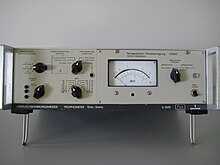Informatics Educational Institutions & Programs
Contents

In telecommunications, a psophometer is an instrument that measures the perceptible noise of a telephone circuit.[1]
The core of the meter is based on a true RMS voltmeter, which measures the level of the noise signal. This was used for the first psophometers, in the 1930s.[2] As the human-perceived level of noise is more important for telephony than their raw voltage, a modern psophometer incorporates a weighting network to represent this perception.[1][2][3] The characteristics of the weighting network depend on the type of circuit under investigation, such as whether the circuit is used to normal speech standards (300 Hz – 3.3 kHz), or for high-fidelity broadcast-quality sound (50 Hz – 15 kHz).[1]
Etymology
The name was coined in the 1930s, on a basis from Ancient Greek: ψόφος, romanized: psóphos, lit. 'noise', itself derived from Ancient Greek: ψό, lit. 'an exclamation of disgust'.[4] It is unrelated to Ancient Greek: σοφός, romanized: sóphos, lit. 'wisdom'.
The '-meter' suffix Ancient Greek: μέτρον, romanized: métron, lit. 'tool for measuring' was already widely used in English, but also derives originally from Greek.[4]
See also
References
- ^ a b c Ian Hickman (March 2001). "Balanced circuits". Electronics World. pp. 190–191.
- ^ a b Harbottle, H.R. (August 1938). "The circuit noise-meter (psophometer) and its applications". Journal of the Institution of Electrical Engineers. 83 (500): 261–274. doi:10.1049/jiee-1.1938.0142.
- ^ Psophometer for use on telephone-type circuits. CCITT. 1994 [1970]. Rec. P53.
- ^ a b "Psophometer". Oxford English Dictionary. Archived from the original on December 14, 2017.
 This article incorporates public domain material from Federal Standard 1037C. General Services Administration. Archived from the original on 2022-01-22.
This article incorporates public domain material from Federal Standard 1037C. General Services Administration. Archived from the original on 2022-01-22.

















